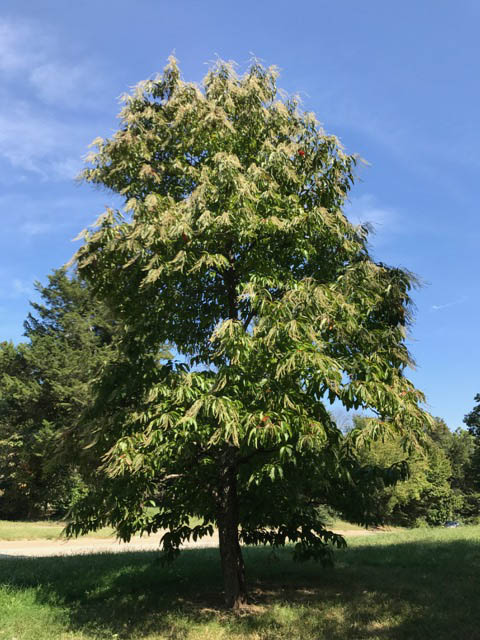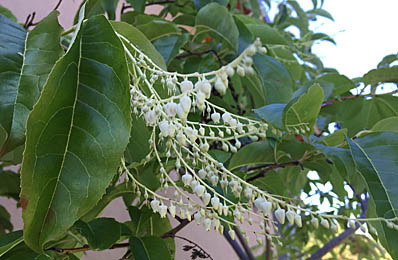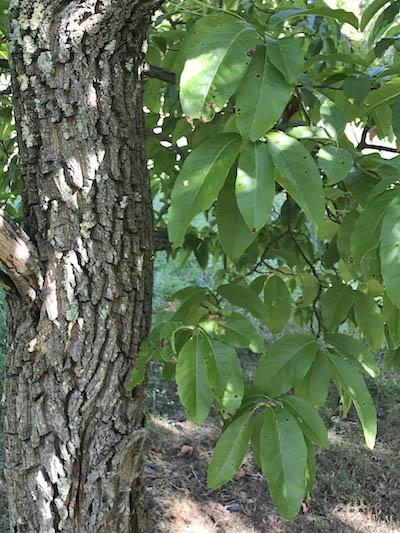Sourwood Tree, Oxydendrum arboretum
By Gretchen Spencer, Fairfax Master Gardener
 I saw my first sourwood tree about two years ago when a neighbor landscaped the corner of her property. The centerpiece was a young tree with long, pendulous seed capsules hanging delicately from its branches. I had no idea what kind of tree it was. I asked a landscape designer friend who said it was a sourwood tree, a native species, and she commented, “They can be a little finicky to grow.” Now I was very curious to learn more about this tree and particularly why a native tree, “one of our best native trees,” according to Michael Dirr, could be tricky to grow.
I saw my first sourwood tree about two years ago when a neighbor landscaped the corner of her property. The centerpiece was a young tree with long, pendulous seed capsules hanging delicately from its branches. I had no idea what kind of tree it was. I asked a landscape designer friend who said it was a sourwood tree, a native species, and she commented, “They can be a little finicky to grow.” Now I was very curious to learn more about this tree and particularly why a native tree, “one of our best native trees,” according to Michael Dirr, could be tricky to grow.
The sourwood tree has several easy-to-identify attributes. Its 3- to 8-inch alternate, finely toothed, simple leaves are a glossy dark green and oblong in shape. The tree typically grows in a pyramidal shape, and its branches are somewhat drooping, as you can see in the photograph. Its flowers and their subsequent seed pods are its most distinguishing characteristics. From June to early July, delicate, creamy white, fragrant flowers on 4- to 8-inch long panicles grace the tree. These flowers resemble lilies-of-the-valley; hence, another common name for this tree is the lily-of-the-valley tree. The flowers give way to tan seed pods that turn silvery in September and remain on the branches after the leaves fall. The bark on mature trees is deeply furrowed, grayish brown, and looks blocky like the bark on a persimmon tree. Besides its lovely flowers and overall graceful appearance, the sourwood tree is known for its brilliant fall colors that vary from crimson red to purple to yellow.
The sourwood tree, Oxydendrum arboreum, derives its name from two Greek words: oxys meaning acid, and dendron meaning tree and refers to the fact that its leaves are sour or acrid tasting. Native to the eastern United States from Pennsylvania south to Florida and Louisiana, the sourwood tree is commonly found growing on the slopes of the Appalachian Mountains. Considered a small- to medium-sized tree, it grows about 25 to 30 feet tall with a spread of about 15 to 20 feet. However, trees found growing in the wild can reach 50 to 60 feet tall. It grows in hardiness zones 5 to 9.
 It is a member of the heath family (Ericaceae), which also includes rhododendrons and azaleas. While it can tolerate part-sun conditions, full sun provides the best flowering and fall color. A few articles that I read on the sourwood tree stated it was a “low-maintenance tree” that had no serious insect or disease problems. Other articles noted that it was a difficult tree to establish in the landscape and that to ensure success, it was important to meet its “exacting cultural requirements.” Those requirements include well-drained, acidic soil. The sourwood does not tolerate dry, compacted or alkaline soils and is sensitive to having its roots disturbed.
It is a member of the heath family (Ericaceae), which also includes rhododendrons and azaleas. While it can tolerate part-sun conditions, full sun provides the best flowering and fall color. A few articles that I read on the sourwood tree stated it was a “low-maintenance tree” that had no serious insect or disease problems. Other articles noted that it was a difficult tree to establish in the landscape and that to ensure success, it was important to meet its “exacting cultural requirements.” Those requirements include well-drained, acidic soil. The sourwood does not tolerate dry, compacted or alkaline soils and is sensitive to having its roots disturbed.
Sourwood trees are also sensitive to air pollution, and they do not do well in urban areas. Planting small, container-grown trees can increase transplant success. Finally, difficulty establishing this tree may also be due to the “temperamental nature of sourwood physiology.” Now, I know what my friend meant when she said the sourwood can be finicky to grow.
Further research also stated that the sourwood tree is host to a fungal leaf spot disease called Tubakia dryina. However, there is no recommended treatment for this except removing plant debris and infected leaves as they appear on the tree. Furthermore, twig and stem borers are also considered serious pests of sourwood. However, there seems to be agreement that the most difficult problems for sourwood arise because of its exacting cultural requirements as stated above.

Bark and leaves
There are several other common names for Oxydendrum arboreum besides sourwood tree including sorrel tree, sorrel gum, sour gum, arrow wood, elk tree, lily-of-the-valley tree and titi tree.
Regardless of its common name, Oxydendrum arboreum is a beautiful native tree whose many noteworthy attributes certainly qualify it as “one of our best native trees,” as noted by leading horticultural expert Michael Dirr. Since first discovering this tree in my neighbor’s yard, I have discovered three mature sourwood specimens growing along the George Washington Memorial Parkway south of Alexandria. Their graceful, arching branches, deep green leaves and distinctive flower panicles make them stand out among the other trees.
References
• Sourwood, Oxydendrum arboreum, Arbor Day Foundation
• Sourwood-Oxydendrum arboreum, Heath Family (Ericaceae) University of Kentucky
• Oxydendrum arboreum, Missouri Botanical Garden
• Sourwood, Oxydendrum arboreum, Virginia Cooperative Extension
• Stress & Pest Impacts on Oxydendrum arboreum/Sourwood, The University of Georgia, Outeach
Publication SFNRO6-13
• Help for a struggling Sourwood tree, Delaware County, PA, State Master Gardeners
• Dirr’s Encyclopedia of Trees and Shrubs, by Michael A. Dirr, 2011